
Corals are marine invertebrates within the class Anthozoa of the phylum Cnidaria. They typically form compact colonies of many identical individual polyps. Coral species include the important reef builders that inhabit tropical oceans and secrete calcium carbonate to form a hard skeleton.

Anthozoa is a class of marine invertebrates which includes the sea anemones, stony corals and soft corals. Adult anthozoans are almost all attached to the seabed, while their larvae can disperse as part of the plankton. The basic unit of the adult is the polyp; this consists of a cylindrical column topped by a disc with a central mouth surrounded by tentacles. Sea anemones are mostly solitary, but the majority of corals are colonial, being formed by the budding of new polyps from an original, founding individual. Colonies are strengthened by calcium carbonate and other materials and take various massive, plate-like, bushy or leafy forms.
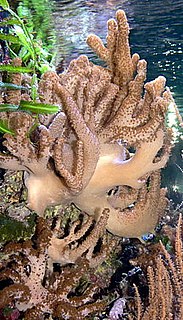
Alcyonacea, or soft corals, are an order of corals. In addition to the fleshy soft corals, the order Alcyonacea now contains all species previously known as "gorgonian corals", that produce a more or less hard skeleton, though quite different from "true" corals (Scleractinia). These can be found in suborders Holaxonia, Scleraxonia, and Stolonifera. They are sessile colonial cnidarians that are found throughout the oceans of the world, especially in the deep sea, polar waters, tropics and subtropics. Common names for subsets of this order are sea fans and sea whips; others are similar to the sea pens of related order Pennatulacea. Individual tiny polyps form colonies that are normally erect, flattened, branching, and reminiscent of a fan. Others may be whiplike, bushy, or even encrusting. A colony can be several feet high and across, but only a few inches thick. They may be brightly coloured, often purple, red, or yellow. Photosynthetic gorgonians can be successfully kept in captive aquaria.

The habitat of deep-water corals, also known as cold-water corals, extends to deeper, darker parts of the oceans than tropical corals, ranging from near the surface to the abyss, beyond 2,000 metres (6,600 ft) where water temperatures may be as cold as 4 °C (39 °F). Deep-water corals belong to the Phylum Cnidaria and are most often stony corals, but also include black and thorny corals and soft corals including the Gorgonians. Like tropical corals, they provide habitat to other species, but deep-water corals do not require zooxanthellae to survive.

Gorgonocephalus is a genus of marine basket stars in the class Ophiuroidea. Members of this genus are found in coldwater environments including the Arctic, the Antarctic, and deep-sea habitats. The scientific name comes from the Greek, gorgós meaning "dreaded" and -cephalus meaning "head", and refers to the similarity between these echinoids and the Gorgon's head from Greek myth with its coiled serpents for hair. The Greek mythological hero Perseus beheaded the Gorgon Medusa; when Perseus later dropped Medusa's head on the beach, her petrifying glance turned the nearby seaweed to stone, creating the first coral.

Leptogorgia virgulata, commonly known as the sea whip or colorful sea whip, is a species of soft coral in the family Gorgoniidae.

Gorgonocephalus eucnemis is a species of basket star in the class Ophiuroidea. It is found in circumpolar marine environments in the Northern Hemisphere. The scientific name for the genus comes from the Greek, gorgós meaning "dreadful" and cephalus meaning "head", and refers to the similarity between these basket stars and the Gorgon's head from Greek mythology with its writhing serpents for hair. The specific name "eucnemis" is from the Greek "good" and "boot".

Gersemia is a genus of soft corals in the family Nephtheidae. Species in this genus are found in cold temperate and polar seas at depths ranging from 20 metres (66 ft) to over 2,000 metres (6,600 ft). The type species is Gersemia loricata.
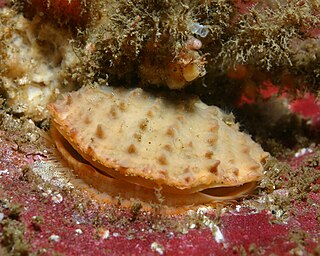
Crassadoma is a genus of rock scallops, marine bivalve molluscs in the family Pectinidae. It is monotypic, the only species being Crassadoma gigantea, the rock scallop, giant rock scallop or purple-hinge rock scallop. Although the small juveniles are free-swimming, they soon become sessile, and are cemented to the substrate. These scallops occur in the eastern Pacific Ocean.

Gorgonia ventalina, the purple sea fan, is a species of sea fan, an octocoral in the family Gorgoniidae. It is found in the western Atlantic Ocean and the Caribbean Sea.
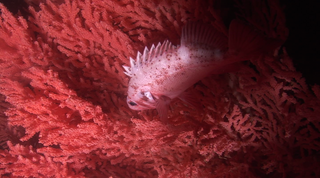
Primnoa(Lamororux, 1812) also known as red tree coral, is a genus of soft corals and the type genus of the family Primnoidae (Milne Edwards, 1857). They are sessile, benthic cnidarians that can be found in the North Pacific, North Atlantic, and Subantarctic South Pacific, and its members often play a vital ecological role as keystone species within their environment as a habitat and refuge for the megafauna that also inhabit those regions. This, in combination with their slow growth, makes the increasing disturbance to their habitats caused by fishing activities particularly impactful and difficult to recover from.

Paragorgia arborea is a species of coral in the family Paragorgiidae, commonly known as the bubblegum coral because of its bulbous branch tips. It mainly grows in depths between 200 and 1,300 metres at temperatures between 3 and 8 °C. It is found widespread in the Northern Atlantic Ocean and Northern Pacific Ocean on seamounts and knolls, and was first described by the Swedish naturalist Carl Linnaeus in 1758. P. arborea is a foundation species, providing a habitat for other species in deep sea coral ecosystems.
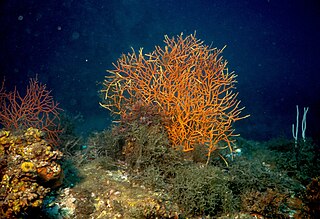
Leptogorgia sarmentosa is a species of colonial soft coral, a sea fan in the family Gorgoniidae. It is native to the eastern Atlantic Ocean and the western Mediterranean Sea, with a single find in the eastern Mediterranean.

Clavularia crassa is a species of colonial soft coral in the family Clavulariidae. It is found in the eastern Atlantic Ocean and the Mediterranean Sea. It was first described in 1848 by the French zoologist Henri Milne-Edwards from a specimen collected off the coast of Algeria.
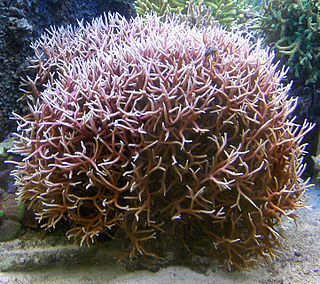
Seriatopora hystrix is a species of colonial stony coral in the family Pocilloporidae. It forms a branching clump and is commonly known as thin birdsnest coral. It grows in shallow water on fore-reef slopes or in sheltered lagoons, the type locality being the Red Sea. It is native to East Africa, the Red Sea and the western Indo-Pacific region. It is a common species and the International Union for Conservation of Nature has assessed its conservation status as being of "least concern".

Gorgonia mariae, commonly known as the wide-mesh sea fan, is a species of sea fan, a sessile colonial soft coral in the family Gorgoniidae. It occurs in the tropical western Atlantic Ocean and the Caribbean Sea at depths down to about 50 m (160 ft).

Plumapathes pennacea is a species of black coral in the order Antipatharia. It is found in the tropical Indian, Pacific and Atlantic Oceans in deep reef habitats where it forms part of a biologically diverse community.
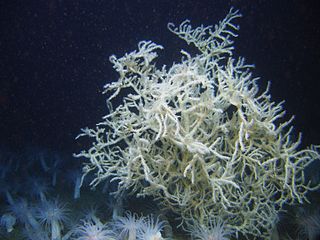
Leiopathes glaberrima is a species of black coral of the order Antipatharia found in the northern Atlantic Ocean and the Mediterranean Seas deep water habitats. A very slow-growing species, it is among the oldest living animals on the planet.

Gersemia fruticosa is a species of soft coral in the family Nephtheidae. It is a deep sea species with a boreal distribution and is found in the northwest Atlantic Ocean, from off the coast of Delaware northward to Baffin Bay and the Davis Strait, and also in the northeast Atlantic Ocean in the Barents Sea.

Gersemia juliepackardae is a species of soft coral in the family Nephtheidae. It is found in the northeast Pacific Ocean, on seamounts or on the deep ocean bed. The coral is named in honour of Julie Packard, the executive director of the Monterey Bay Aquarium, for "her dedication to ocean stewardship and conservation, and for elevating public awareness about the ocean environment."



















